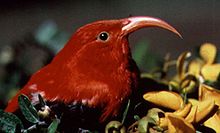Mamos
| Mamos | ||||||||||||
|---|---|---|---|---|---|---|---|---|---|---|---|---|

Soot Mamo ( Drepanis funerea ) |
||||||||||||
| Systematics | ||||||||||||
|
||||||||||||
| Scientific name | ||||||||||||
| Drepanis | ||||||||||||
| Temminck , 1820 |
The Mamos ( Drepanis ) are a genus of songbirds from the tribe of the honeysuckle (Drepanidini). The genus includes two modern extinct species and a critically endangered species, the Iiwi .
features
Both extinct Mamo species had long, crescent-shaped beaks. The King's Clothes Bird or Mamo ( Drepanis pacifica ) was about 23 cm tall. Most of the plumage was glossy black. The back of the back, the rump, the upper tail covers, the upper flanks and the thigh plumage were shiny golden yellow. The beak and legs were dark brownish black. The soot mamo ( Drepanis funerea ) reached a length of 20 cm. The plumage was almost one color, dull black, only the hand wings had gray outer flags .
The Iiwi also has a long, sickle-shaped beak, but is generally dark red in color.
distribution
The royal clothes bird occurred on the island of Hawaii , especially on Hualālai , above Waimea in Kohala and between the Kīlauea and Hilo . The soot mamo was common in Molokaʻi , Maui , Lānaʻi and Kahoʻolawe . Subfossil material is known only from the soot mamo from the island of Maui.
Systematics

Based on John Latham's Great Hook-billed Creeper , the Königskleidervogel was described by Johann Friedrich Gmelin as Certhia pacifica in 1788 . In 1820 Coenraad Jacob Temminck created the Drepanis genus . In 1903 Robert Cyril Layton Perkins summarized the genera Drepanis , Vestiaria , Ciridops , Himatione and Palmeria as a subgroup. 1979 Harold Douglas Pratt synonymized the monotypic genus Vestiaria (Iiwi) with the genus Drepanis , which is now accepted by most authors.
status
In 1892 a king-size bird was caught alive and photographed for the last time. In 1898, Henry W. Henshaw observed the last known couple.
The soot mamo was one of the last species of honeysuckle to be discovered by science. In 1893 Robert Cyril Layton Perkins caught the first known specimen of this species on Molokai, in 1907 the last three specimens were collected by William Alanson Bryan .
The iiwi, which was quite numerous just a few decades ago, is now under great threat. It is estimated that its population has decreased from around 350,000 in the 1990s to just 2,600 in 2017.
Cultural meaning
The royal clothes bird was one of the first types of clothes birds to be discovered by European settlers and is considered to be the namesake for the entire subfamily of clothes birds. Although the mamos were already rare when the European settlers settled Hawaii, they had an important place in Hawaiian culture. They were the source of the black and yellow feathers from which the precious cloaks, called ahu-ula in Hawaiian, were made for the Hawaiian princes. The term mamo has been used as a synonym for ahu-ula. According to the anthropologist Peter Henry Buck , ahu-ula means “red robe”. The yellow feathers of the king's clothes bird were preferred to the feathers of the curly tails ( Moho ) and other clothes birds. On the one hand, this was due to the richer colors and, on the other hand, the difficulty of getting them. The feathers of the flanks and rump were called koʻo mamo and the feathers of the thighs were called ʻae mamo. According to Scott Barchard Wilson and Arthur Humble Evans, among the larger feathered capes in the British Museum of Natural History, there are specimens with diamond-shaped patterns of dark yellow feathers interspersed with the more common bright yellow feathers. A cloak is made entirely from the feathers of the king's clothes bird (including the black ones). Most famous, however, is the so-called "million dollar cape" of the Hawaiian King Kamehameha I , which is now in the Bernice P. Bishop Museum and contains 450,000 Mamo feathers. Mamo feathers can be considered the " crown jewels " of Hawaii.
literature
- Harold Douglas Pratt: The Hawaiian Honeycreepers. Oxford University Press, 2005, ISBN 0-19-854653-X .
- H. Douglas Pratt (2002): Black Mamo (Drepanis funerea) . In: The Birds of North America Online. (A. Poole, Ed.). Ithaca: Cornell Lab of Ornithology; Retrieved from the Birds of North America Online: http://bna.birds.cornell.edu/bna/species/640b
Web links
Individual evidence
- ^ Perkins, RCL (1903): Vertebrata. Pp. 365-466 in: Fauna Hawaiiensis or the zoology of the Sandwich. Vol. 1, pt IV (Isles, Hawaiian), Ed. Univ. Press, Cambridge, UK
- ^ Pratt, H. Douglas (1979): A systematic analysis of the endemic Avifauna of the Hawaiian Islands . dissertation
- ↑ a b Drepanis coccinea in the IUCN Red List of Threatened Species 2017.3. Posted by: BirdLife International, 2016. Retrieved February 2018.
- ^ Isabella Lucy Bird (1881): Six months in the Sandwich Islands: among Hawai'i's palm groves, coral reefs, and volcanoes. GP Putnam's Sons, New York.
- ^ A b Peter H. Buck (1964): Arts and Crafts of Hawaii, Section V. Clothing. BP Bishop Mus. Spec. Publ. 45: pp. 533-563 and 581-585
- ^ Wilson, SB and AH Evans (1890): Aves Hawaiiensis: the birds of the Sandwich Islands. RH Porter, London.